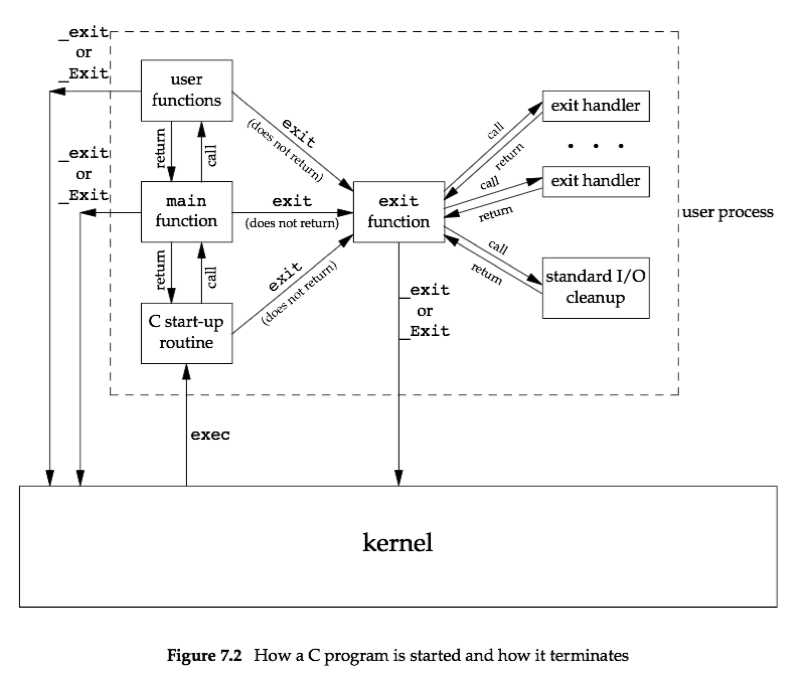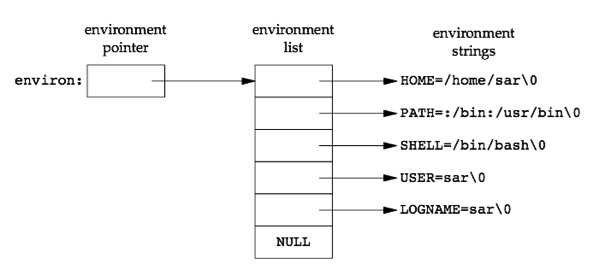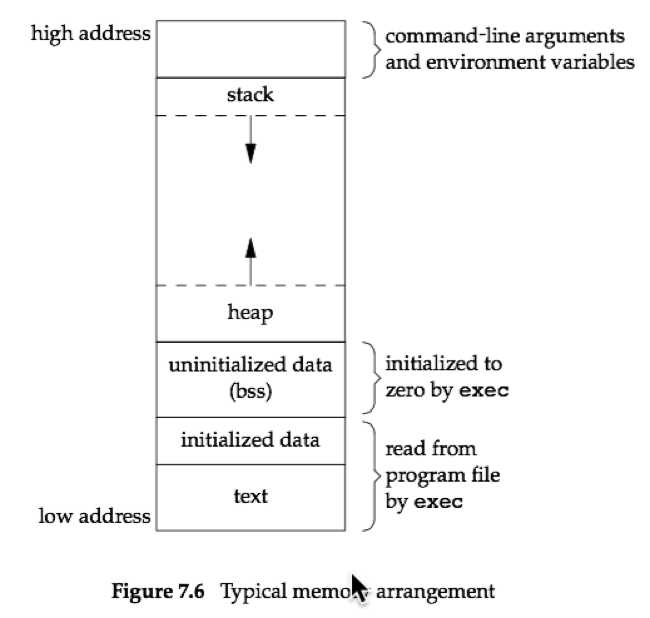标签:
在学习进程控制相关知识之前,我们需要了解一个单进程的运行环境。
本章我们将了解一下的内容:
- 程序运行时,main函数是如何被调用的;
- 命令行参数是如何被传入到程序中的;
- 一个典型的内存布局是怎样的;
- 如何分配内存;
- 程序如何使用环境变量;
- 程序终止的各种方式;
- 跳转(longjmp和setjmp)函数的工作方式,以及如何和栈交互;
- 进程的资源限制
?
1 main函数
main函数声明:
int main (int argc, char *argv[]);
参数说明:
- argc:命令行参数个数
- argv:指向参数列表数组的指针
main函数启动前:
- C程序由内核执行,通过系统调用exec;
- main函数调用前,执行指定的启动路径(start-up routine);
- 可执行文件认为此地址为程序的启动地址,该地址由链接器指定;
- 启动路径从内核获取参数列表和环境变量,使得main函数可以在稍后被调用时可以获取这些变量。
?
2 进程终止
一共有8中终止进程的方式,5种正常终止和3种异常终止。
5种正常终止:
- 从main函数返回;
- 调用exit;
- 调用_exit或_Exit;
- 最后一个线程返回;
- 最后一个线程调用pthread_exit。
3种异常终止:
- 调用abort;
- 接收到一个信号;
- 最后一个线程应答或者一个接收到一个退出请求
启动地址(start-up routine)同样也是main函数的返回地址。
要获取该地址,可以通过以下的方式:
exit (main(argc, argv));
?
退出函数
函数声明:
#include <stdlib.h>
void exit(int status);
void _Exit(int status);
#include <unistd.h>
void _exit(int status);
函数细节:
- _exit和_Exit立刻返回到内核;
- exit函数返回内核前会进行一些清理环境工作;
返回一个整数和调用exit函数,并传入该整数的作用是相同的:
exit(0);
return 0;
?
atexit函数
函数声明
#include <stdlib.h>
int atexit(void (*func)(void));
函数细节
- 每个进程可以注册32个函数,这些函数可以在主函数调用exit时自动被调用
- 通过atexit注册的退出时处理函数称为退出句柄(exit handlers)
- 这些退出句柄的调用顺序为注册时的相反顺序
- exit函数第一次调用退出句柄时,会关闭所有打开的流
- 如果主程序调用了exec系列函数,则所有注册的退出句柄都会被清空
?
程序启动和终止流程图
?
Example:
#include "apue.h"
?
static void my_exit1(void);
static void my_exit2(void);
?
int
main(void)
{
? ? if (atexit(my_exit2) != 0)
? ? ? ? err_sys("can‘t register my_exit2");
?
? ? if (atexit(my_exit1) != 0)
? ? ? ? err_sys("can‘t register my_exit1");
? ? if (atexit(my_exit1) != 0)
? ? ? ? err_sys("can‘t register my_exit1");
?
? ? printf("main is done\n");
? ? return(0);
}
?
static void
my_exit1(void)
{
? ? printf("first exit handler\n");
}
?
static void
my_exit2(void)
{
? ? printf("second exit handler\n");
}
?执行结果:

?
3 命令行参数
Example:
#include "apue.h"
?
int
main(int argc, char *argv[])
{
? ? int ? ? i;
?
? ? for (i = 0; i < argc; i++)? ? ? /* echo all command-line args */
? ? ? ? printf("argv[%d]: %s\n", i, argv[i]);
? ? exit(0);
}
执行结果:
 ?
?
?
4 环境变量列表
每个程序会接受一个环境变量列表,该列表是一个数组,由一个数组指针指向,该数组指针类型为:
extern char **environ;
例如,如果环境变量里有5个字符串(C风格字符串),如下图所示:

5 C程序的内存布局
典型的C程序的内存布局如下图所示:

上图说明:
- 文本段(Text Segment),保存CPU将要执行的机器指令。文本段是可共享的,所以某个程序多次执行时,对应的文本段只需要在内存中存有一份拷贝。文本段是只读的(read-only),防止程序的指令被修改。
- 已初始化数据段(initialized data segment),保存程序中被初始化的全局变量(定义在任何函数之外)。例如:int maxcount = 99; 全局变量变量maxcount被保存在初始化数据段。
- 未初始化数据段(uninitialized data segment),也被称为BSS(block started by symbol),这个段中的数据在程序执行之前被内核初始化为0或者null。;例如定义一个全局变量(定义在任何函数之外),long sum[1000]; ?该变量保存在未初始化数据段中。
- 栈(Stack):存储临时变量,函数相关信息。当一个函数被调用时,返回地址、调用者相关信息(如寄存器信息)会被保存在栈中。该被调用的函数会在栈上分配一部分空间保存它的临时变量。函数的递归调用也是应用这个原理。每一次函数调用自己,都会保存当前函数的信息,然后再栈上开辟一个新的空间用于保存该次函数的信息,和以前的函数并没有影响。
- 堆(Heap):动态内存分配位置。堆的位置位于未初始化数据段和栈的中间。
?
6 内存分配(Memory Allocation)
有三个函数可以用于内存分配:
- malloc:分配指定字节数的内存,未初始化。
- calloc:分配指定数目的对象大小的内存,内存初始化为0;
- realloc:增加或减小之前分配的内存。移动旧内存的内容到新的更大的内存块,多余的部分内存未初始化。
函数声明:
#include <stdlib.h>
void *malloc(size_t size);
void *calloc(size_t nobj, size_t size);
void *realloc(void *ptr, size_t newsize);
void free(void* ptr);
函数细节:
- 三个函数返回的内存指针一定是内存对齐的,这样可以用来保存于不同的对象;
- free函数用于释放ptr指向的内存,被分配的内存放入内存池中用于下次的内存分配;
- realloc函数用于改变之前分配的内存的大小。比如运行时我们申请了一段内存用于存储512个元素的数组,后来发现内存大小不够,这时可以调用realloc。如果操作系统发现在当前内存的后面有足够的内存,则直接分配多余的内存到当前内存中,然后返回传入的指针(即直接扩展内存)。但是如果当前内存后面没有足够大小的空间,则系统重新分配一个足够大的内存,将旧内存块中得内容拷贝到新内存块中,然后返回新内存的地址。
- 内存分配函数使用系统调用sbrk来实现。该系统调用的作用是扩展进程的堆。
- 一般实际分配的内存块都比请求的要大,多出来的部分用来存储内存块大小、指向下一内存块的指针等信息。写覆盖信息记录区的错误是非常隐蔽而且严重的。
?
7 环境变量(Environment Variable)
环境变量的字符串形式:
name=value
?内核不关注环境变量,各种应用才会使用环境变量。
获取环境变量值使用函数getenv。
#include <stdlib.h>
char* getenv(const char* name);
// Returns: pointer to value associated with name, NULL if not found
修改环境变量的函数:
#include <stdlib.h>
int putenv(char* str);
int setenv(const char* name, const char* value, int rewrite);
int unsetenv(const char* name);
?函数细节:
- 函数putenv传入一个字符串,形式为name=value,加入到环境变量列表中。如果name已经存在,先删除旧的定义。
- 函数setenv传入一个name和一个value,如果name已经存在,则参数rewrite决定是否覆盖旧的定义,如果rewrite为非零,则会覆盖旧的定义。
- 函数unsetenv删除name的定义,如果name不存在,也不报错。?
?修改环境变量列表的过程是一件很有趣的事情
从上面的C程序内存布局图中可以看到,环境变量列表(保存指向环境变量字符串的一组指针)保存在栈的上方内存中。
在该内存中,删除一个字符串很简单。我们只需要找到该指针,删除该指针和该指针指向的字符串。
但是增加或修改一个环境变量困难得多。因为环境变量列表所在的内存往往在进程的内存空间顶部,下面是栈。所以该内存空间无法被向上或者向下扩展。
所以修改环境变量列表的过程如下所述:
- 如果我们修改一个已经存在的name:
- 如果新的value的大小比已经存在的value小或者相当,直接覆盖旧的value;
- 如果新的value的大小比已经存在的value大,则我们必须为新的value malloc一个新的内存空间,拷贝新value到该内存中,替换指向旧value的指针为指向新value的指针。
- 如果我们新增一个环境变量:
- 首先我们需要调用malloc为字符串name=value分配空间,拷贝该字符串到目标内存中;
- 如果这是我们第一次添加环境变量,我们需要调用malloc分配一个新的空间,拷贝老的环境量列表到新的内存中,并在列表后新增目标环境变量。然后我们设置environ指向新的环境变量列表。
- 如果这不是我们第一次新增环境变量,则我们只需要realloc多分配一个环境变量的空间,新增的环境变量保存在列表尾部,列表最后仍然是一个null指针。
?
小结
本篇介绍了进程的启动和退出、内存布局、环境变量列表和环境变量的修改。
下一篇将接着学习四个函数setjmp、longjmp、getrlimit和setrlimit。
?
?
参考资料:
《Advanced Programming in the UNIX Envinronment 3rd》
UNIX高级环境编程(8)进程环境(Process Environment)- 进程的启动和退出、内存布局、环境变量列表
标签:
原文地址:http://www.cnblogs.com/suzhou/p/4319166.html


 ?
?
